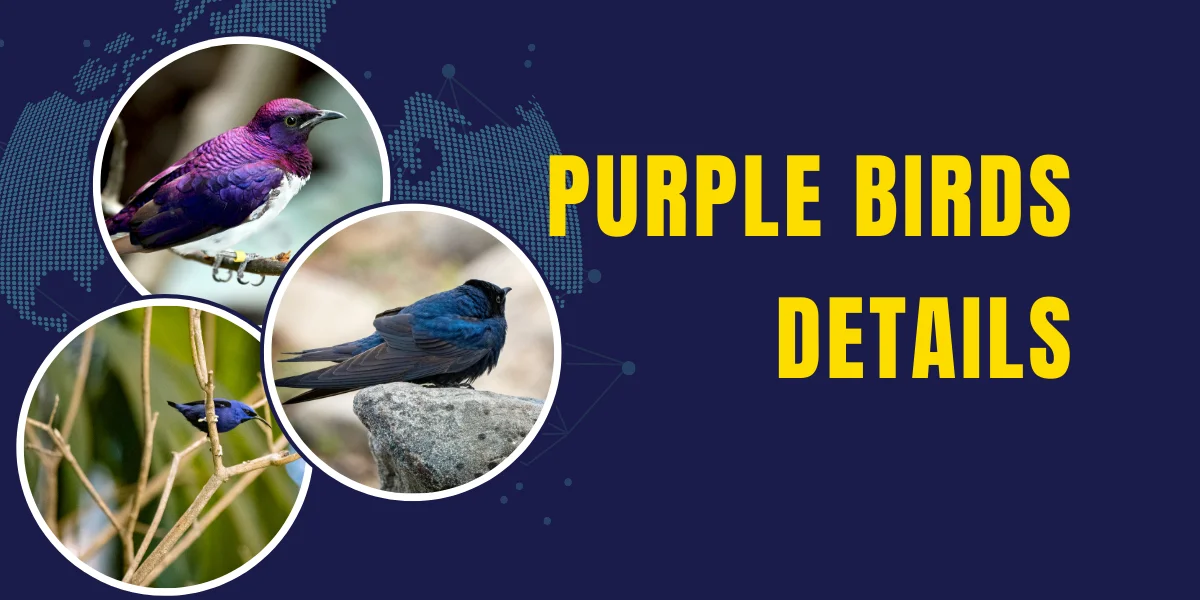Purple birds are some of the most beautiful and unique birds you can find. Their stunning purple feathers make them stand out in nature. These birds can be found in different parts of the world, and each species has its own charm. From bright purple to soft violet shades, these birds bring a splash of color to forests, gardens, and even your backyard. In this article, we’ll explore some of the most interesting purple birds, where they live, and what makes them special.
10 Purple Birds
- Purple Martin – A North American swallow with deep purple feathers.
- Violet-crowned Woodnymph – A hummingbird with a violet crown and purple body.
- Purple Sunbird – A small South Asian bird with shiny purple feathers during breeding.
- Purple Grenadier – An African finch with vibrant purple feathers.
- Purple Honeycreeper – A small, bright purple-blue bird found in South America.
- Violet-backed Starling – An African bird with a shiny purple back.
- Splendid Sunbird – A brightly colored African bird with purple accents.
- Purple-breasted Cotinga – A South American bird with a purple chest and body.
- Amethyst Starling – A glittering purple bird from Africa.
- Purple-throated Euphonia – A bird with a purple throat found in Central and South America.
10 Purple Birds Details
Purple birds are among the most beautiful birds in nature. Their colorful feathers are eye-catching and make them stand out wherever they live. Some birds have bright purple feathers, while others have a mix of purple with other colors like green, blue, or red. These birds live in different parts of the world and have unique habits and features. In this article, we will explore 10 stunning purple birds, their habitats, diets, and interesting facts.
1. Purple Martin
Description
The Purple Martin is a large swallow found in North America. Males have deep, shiny purple feathers that can look black in the right light. Females and younger Purple Martins don’t have as much purple. They are mostly gray with light purple on their backs. These birds are known for their smooth flight and long, pointed wings.
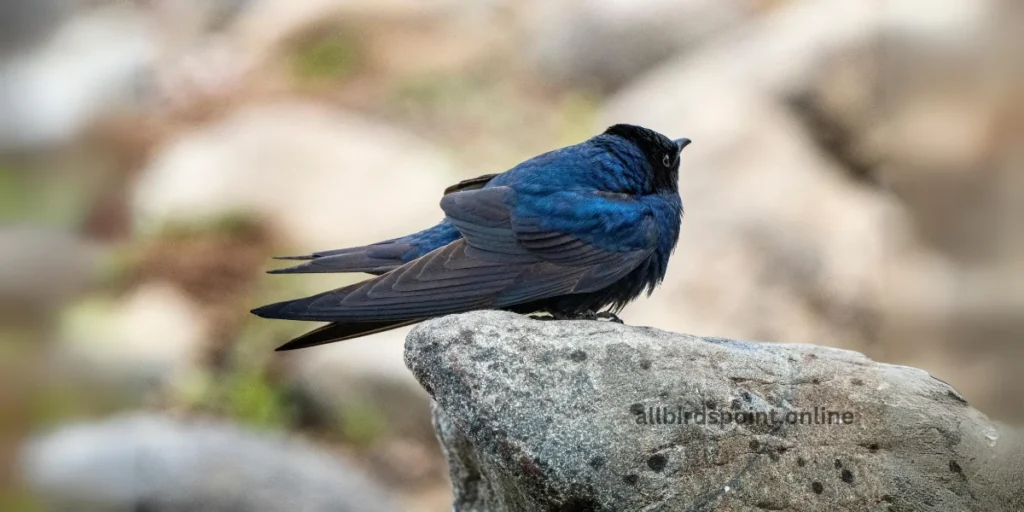
Habitat
Purple Martins live in open spaces near water, such as lakes, rivers, and ponds. They enjoy flying high in the sky to catch insects. In the past, they made nests in hollow trees, but now, they rely on human-made birdhouses. They live in many parts of North America, especially in the eastern United States.
Diet
Purple Martins eat flying insects. They are skilled at catching insects while flying. Some of their favorite insects include beetles, flies, moths, and dragonflies. You won’t see them at bird feeders because they prefer hunting for food in the air.
Interesting Fact
Purple Martins are migratory birds. In winter, they travel to South America, and in the spring, they return to North America. Their journey covers thousands of miles, making them famous for long-distance travel.
Purple Martin
| Feature | Details |
|---|---|
| Scientific Name | Progne subis |
| Lifespan | 4-5 years in the wild |
| Habitat | Open areas near water, urban areas |
| Diet | Flying insects |
| Interesting Fact | Migratory bird; travels from North America to South America for winter |
2. Violet-crowned Woodnymph
Description
The Violet-crowned Woodnymph is a small hummingbird with a shiny violet head. Males have bright purple and green feathers, while females have more gray and green feathers. The bird’s sparkling feathers make them look magical, especially in the sunlight.
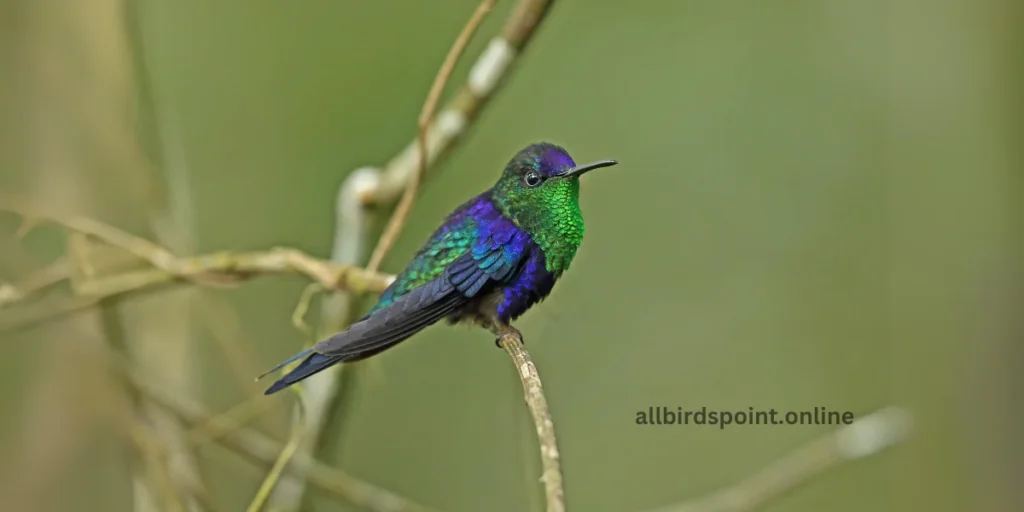
Habitat
These hummingbirds are found in Central and South America. They prefer tropical forests filled with flowers. You can find them in dense areas where there are lots of plants and trees.
Diet
The Violet-crowned Woodnymph feeds on flower nectar. It uses its long beak to reach the nectar deep inside flowers. It also eats tiny insects and spiders to get extra nutrients.
Interesting Fact
These hummingbirds are known for their ability to hover in place. They flap their wings very fast to stay still while they feed on flowers.
Violet-crowned Woodnymph
| Feature | Details |
|---|---|
| Scientific Name | Thalurania glaucopis |
| Lifespan | 3-5 years |
| Habitat | Tropical forests in Central and South America |
| Diet | Nectar, small insects |
| Interesting Fact | Known for its ability to hover while feeding |
3. Purple Sunbird
Description
The Purple Sunbird is a tiny bird found in South Asia. Males have shiny purple and blue feathers during the breeding season to attract females. After the breeding season, they lose their bright colors and become dull brown. Females are always olive-brown, which helps them blend into their surroundings.
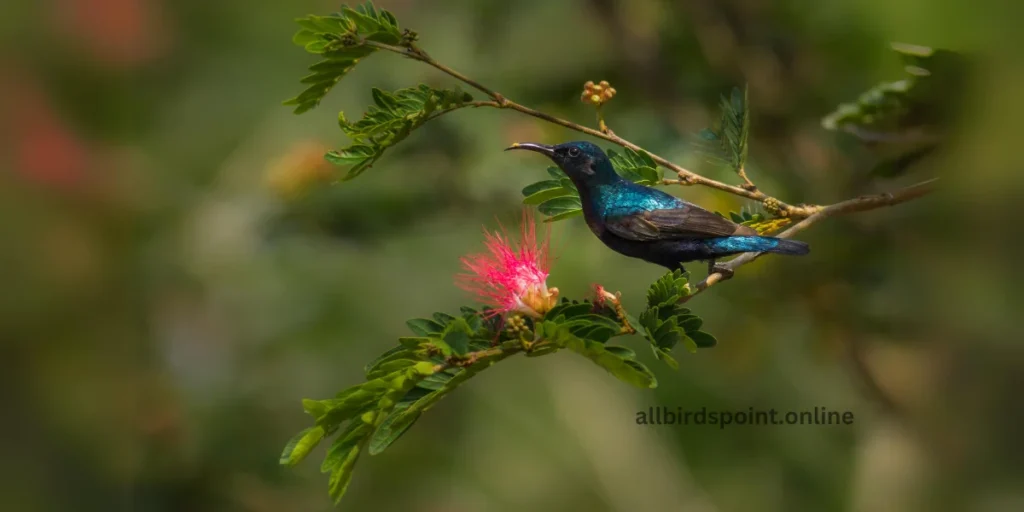
Habitat
Purple Sunbirds live in many places, including forests, gardens, and cities. They are common in countries like India, Sri Lanka, and Pakistan. They are often seen jumping from flower to flower in search of food.
Diet
Purple Sunbirds eat mainly nectar from flowers. Their long beaks help them reach deep into the flowers. They also eat small insects and spiders for extra protein.
Interesting Fact
Male Purple Sunbirds change color during the breeding season. Their purple feathers help them attract mates. Once the season is over, they molt (lose feathers) and return to a dull brown color.
| Feature | Details |
|---|---|
| Scientific Name | Cinnyris asiaticus |
| Lifespan | 3-5 years |
| Habitat | Forests, gardens, urban areas in South Asia |
| Diet | Nectar, small insects |
| Interesting Fact | Males change color during the breeding season |
4. Purple Grenadier
Description
The Purple Grenadier is a small finch from Africa. The males have bright purple feathers, while females have softer brown-purple feathers. Both males and females have red beaks and orange spots near their eyes, which make them stand out.
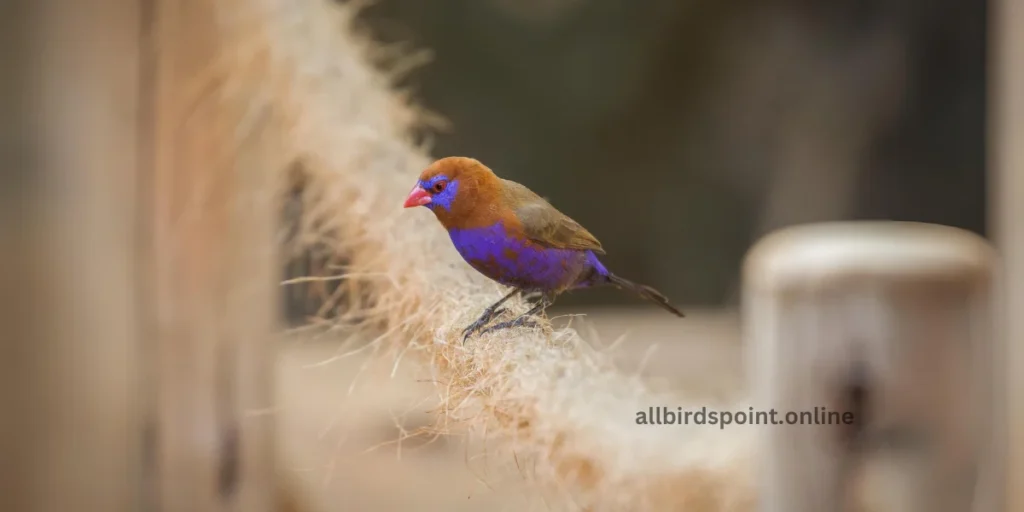
Habitat
Purple Grenadiers live in the dry grasslands and woodlands of East Africa, in countries like Kenya and Tanzania. They prefer areas with shrubs and trees, which provide shelter and nesting spots.
Diet
These birds feed on seeds and small fruits. Their strong beaks help them crack open tough seeds. When raising their young, they also catch small insects for added protein.
Interesting Fact
Some people keep Purple Grenadiers as pets because of their striking colors. However, they are better off in the wild, where they can behave naturally.
Purple Grenadier
| Feature | Details |
|---|---|
| Scientific Name | Uraeginthus ianthinogaster |
| Lifespan | 5-7 years |
| Habitat | Dry grasslands and woodlands in East Africa |
| Diet | Seeds, small fruits, insects |
| Interesting Fact | Often kept as pets due to their striking colors |
5. Purple Honeycreeper
Description
The Purple Honeycreeper is a small bird with purple-blue feathers. The males have bright purple bodies with dark wings and tails, while the females are mostly green with a bit of purple on their heads and wings. They have long, sharp beaks that help them feed on nectar.

Habitat
These birds live in tropical rainforests in Central and South America. They spend most of their time high in the trees, looking for food. They can be found in countries like Brazil and Colombia.
Diet
Purple Honeycreepers love nectar. They use their long beaks to drink the sweet liquid from flowers. They also eat fruit and small insects, which give them the energy they need to stay active.
Interesting Fact
Purple Honeycreepers are part of the tanager family, which is known for its colorful birds. They have long tongues, which help them lick up nectar, much like hummingbirds.
| Feature | Details |
|---|---|
| Scientific Name | Cyanerpes caeruleus |
| Lifespan | 3-4 years |
| Habitat | Tropical rainforests in Central and South America |
| Diet | Nectar, fruit, small insects |
| Interesting Fact | Part of the tanager family, known for hovering while feeding |
6. Violet-backed Starling
Description
The Violet-backed Starling, also known as the Plum-colored Starling, is a bright purple bird from Africa. Males have a shiny violet back, while females are mostly brown with a little bit of purple. The males’ bright feathers help them attract mates.

Habitat
These birds live in sub-Saharan Africa, where they prefer forests and woodlands. They can also be found in more open areas. Violet-backed Starlings often travel in small groups or pairs.
Diet
Violet-backed Starlings eat fruits, berries, and insects. They often catch insects while flying or pick them off leaves and trees. Seeds are also a part of their diet.
Interesting Fact
Male Violet-backed Starlings puff up their feathers and sing during courtship to attract females. Their bright purple feathers make them very eye-catching during the breeding season.
Violet-backed Starling
| Feature | Details |
|---|---|
| Scientific Name | Cinnyricinclus leucogaster |
| Lifespan | 4-6 years |
| Habitat | Forests, woodlands, and savannas in sub-Saharan Africa |
| Diet | Fruits, berries, insects |
| Interesting Fact | Males display bright feathers during courtship |
7. Splendid Sunbird
Description
The Splendid Sunbird is a brightly colored bird found in Africa. Males have deep purple feathers with hints of red and green, while females are brownish-olive. These birds are small but very colorful and beautiful.
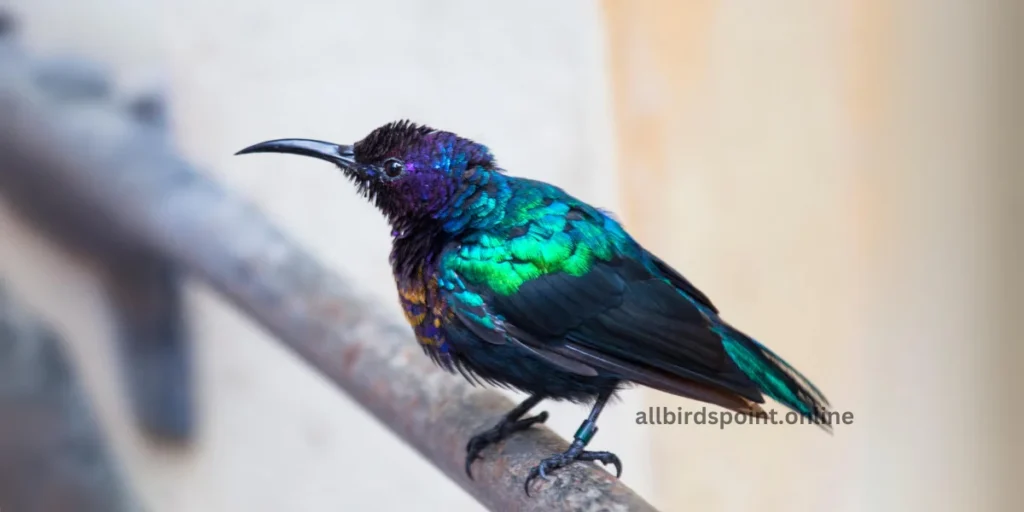
Habitat
Splendid Sunbirds live in tropical forests, gardens, and savannas in Africa. They are usually seen near flowers, where they feed on nectar.
Diet
Like other sunbirds, Splendid Sunbirds feed on nectar from flowers. They also eat small insects and spiders to stay strong. Their curved beaks make it easy for them to reach into flowers.
Interesting Fact
Though they can hover like hummingbirds, Splendid Sunbirds usually perch on branches while drinking nectar.
| Feature | Details |
|---|---|
| Scientific Name | Cinnyris coccinigaster |
| Lifespan | 4-6 years |
| Habitat | Tropical forests, gardens, and savannas in Africa |
| Diet | Nectar, small insects |
| Interesting Fact | Can hover like hummingbirds while feeding |
8. Purple-breasted Cotinga
Description
The Purple-breasted Cotinga is a striking bird from South America. Males have a bright purple chest and blue wings, making them very noticeable. Females are not as colorful, with gray and brown feathers.
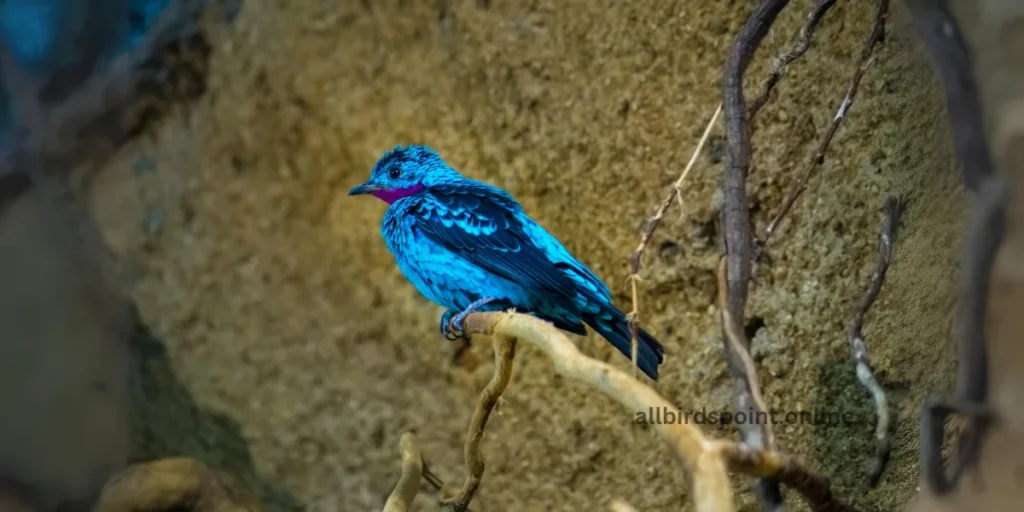
Habitat
These birds live in the rainforests of the Amazon. They like high trees and dense forests where they can stay hidden. Countries like Brazil and Peru are home to this species.
Diet
Purple-breasted Cotingas eat mostly fruits and berries. They help spread seeds by eating fruits and letting the seeds fall in new areas, which helps new plants grow.
Interesting Fact
These birds are often quiet and stay high up in the trees, making them hard to see. Their bright feathers blend in with the colorful surroundings of the rainforest.
| Feature | Details |
|---|---|
| Scientific Name | Cotinga cotinga |
| Lifespan | 4-7 years |
| Habitat | Rainforests in the Amazon basin |
| Diet | Fruits, berries |
| Interesting Fact | Known for their bright colors and elusive nature |
9. Amethyst Starling
Description
The Amethyst Starling is a small, shiny bird with purple feathers that reflect light, making them look like a gem. Males are brightly colored, while females are more muted with brown and gray feathers.
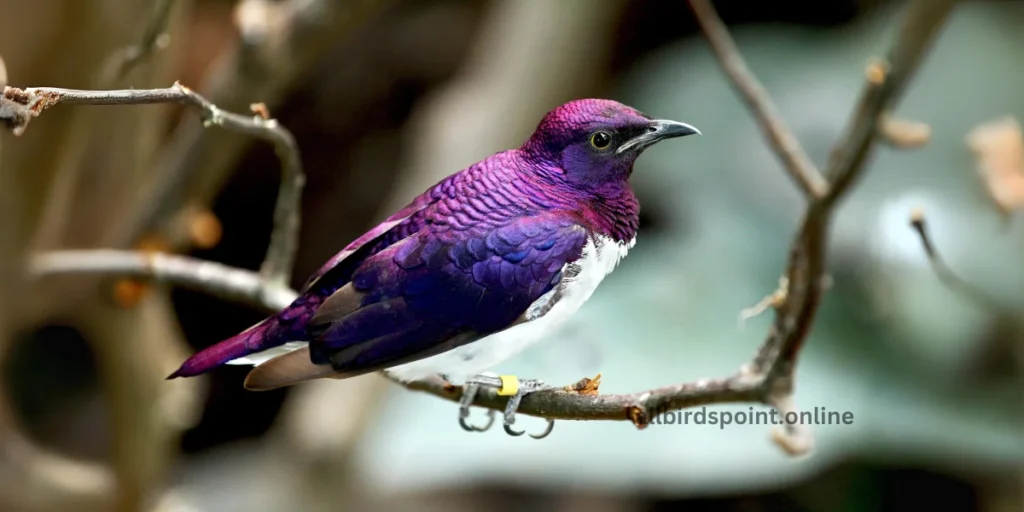
Habitat
These birds live in sub-Saharan Africa. They prefer forests, woodlands, and open savannas. They are social birds and are often seen in small groups.
Diet
Amethyst Starlings eat fruits, berries, seeds, and insects. They often visit fruit trees and shrubs, where they can find plenty to eat. Insects provide them with extra protein.
Interesting Fact
The male Amethyst Starling’s feathers reflect light in a way that makes them shine like a gemstone, which helps them attract females during mating season.
| Feature | Details |
|---|---|
| Scientific Name | Lamprotornis purpureus |
| Lifespan | 5-7 years |
| Habitat | Forests, woodlands, and open savannas in sub-Saharan Africa |
| Diet | Fruits, berries, seeds, insects |
| Interesting Fact | Males have iridescent feathers that reflect light like gemstones |
10. Purple-throated Euphonia
Description
The Purple-throated Euphonia is a small, vibrant songbird found in Central and South America. The males have glossy, dark purple throats and heads, with a contrasting bright yellow belly. Females, on the other hand, are more muted in color, with olive-green backs and lighter yellow underparts. The males’ striking combination of purple and yellow makes them stand out in the tropical forests where they live.
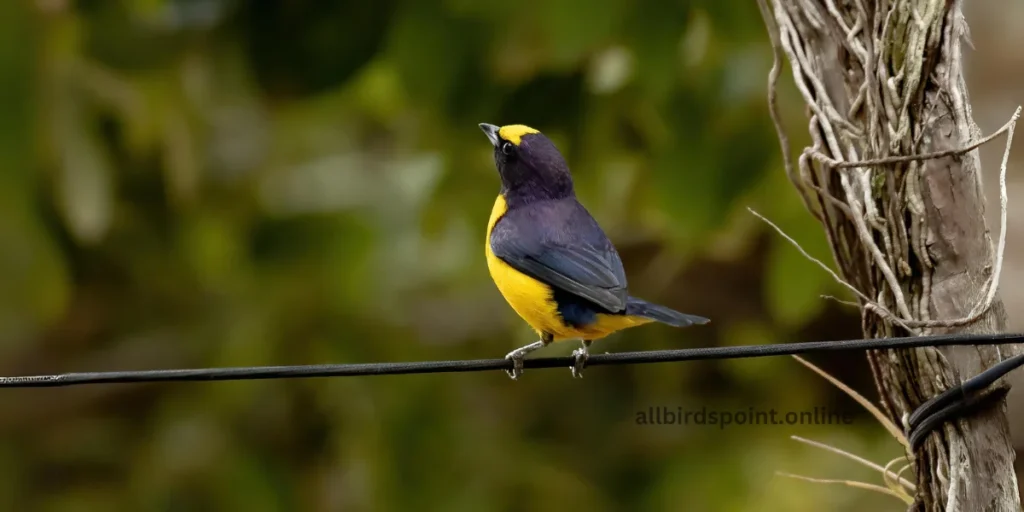
Habitat
Purple-throated Euphonias are commonly found in the tropical and subtropical forests of countries like Costa Rica, Panama, and parts of northern South America. They prefer areas with dense vegetation, such as rainforests, gardens, and even forest edges. These birds are often seen in the canopy, flitting between trees as they search for food.
Diet
The Purple-throated Euphonia feeds primarily on fruits, especially small berries and figs. They use their short, thick beaks to easily pluck fruit from trees. Occasionally, they also eat insects and small invertebrates to add some variety to their diet.
Interesting Fact
Unlike many other birds, the Purple-throated Euphonia often forms pairs that stay together year-round. These birds are known for their musical duets, where both the male and female sing together in harmony. This strong bond helps them stay connected while defending their territory.
| Feature | Details |
|---|---|
| Scientific Name | Euphonia chlorotica |
| Lifespan | Approximately 5-7 years |
| Habitat | Tropical and subtropical forests in Central and South America, including countries like Costa Rica, Panama, and Colombia |
| Diet | Fruits, small berries, nectar, and insects |
| Interesting Fact | Known for their musical duets; males and females often sing together in harmony throughout the year |
Purple birds are fascinating, with their unique colors and behaviors. Whether they live in tropical forests, dry deserts, or open grasslands, each one of these birds plays an important role in its ecosystem. From the insect-eating Purple Martin to the nectar-loving Purple Honeycreeper, these birds add beauty and life to the world around them. If you ever have the chance to see one of these purple birds in the wild, it will surely be an unforgettable experience
FAQs
1. What are purple birds?
- Purple birds are birds with purple feathers. They can be fully purple or have purple as a prominent color in their plumage.
2. Where can you find purple birds?
- Purple birds can be found in various parts of the world, including tropical forests, grasslands, and urban areas, depending on the species.
3. What do purple birds eat?
- Their diet varies by species. Many eat insects, fruits, nectar, or seeds.
4. Are purple birds rare?
- Some purple birds are rare, while others are more common. Their rarity often depends on their habitat and conservation status.
5. What is the most colorful purple bird?
- The most colorful purple birds include the Violet-crowned Woodnymph and the Purple Honeycreeper, known for their vibrant and striking plumage.
6. Do purple birds migrate?
- Some purple birds are migratory, traveling between breeding and wintering grounds, while others are resident or sedentary, staying in the same area year-round.
7. How can I attract purple birds to my garden?
- To attract purple birds, provide bird feeders with seeds, fruits, and nectar, and create a welcoming habitat with plants and water sources.
.
